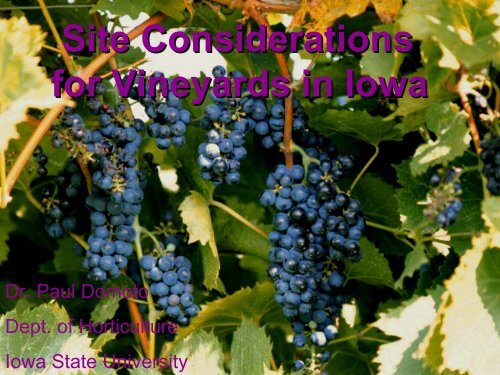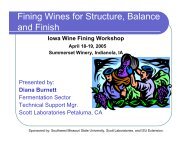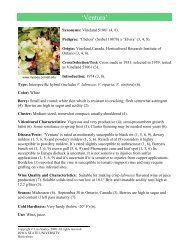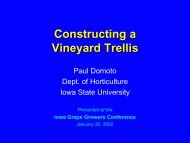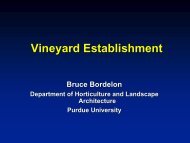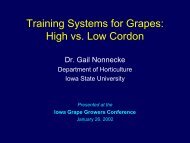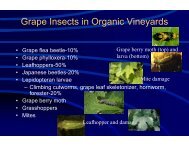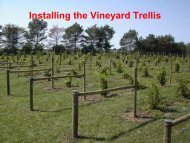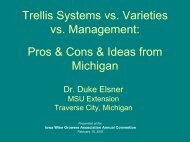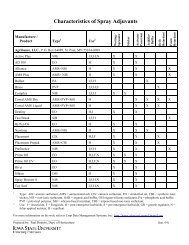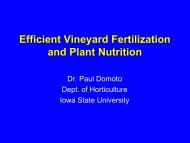Site Considerations for Vineyards in Iowa - Viticulture Iowa State ...
Site Considerations for Vineyards in Iowa - Viticulture Iowa State ...
Site Considerations for Vineyards in Iowa - Viticulture Iowa State ...
You also want an ePaper? Increase the reach of your titles
YUMPU automatically turns print PDFs into web optimized ePapers that Google loves.
<strong>Site</strong> <strong>Considerations</strong><br />
<strong>for</strong> <strong>V<strong>in</strong>eyards</strong> <strong>in</strong> <strong>Iowa</strong><br />
Dr. Paul Domoto<br />
Dept. of Horticulture<br />
<strong>Iowa</strong> <strong>State</strong> University
<strong>Site</strong> <strong>Considerations</strong><br />
Climate<br />
• W<strong>in</strong>ter<br />
Temperatures<br />
• Spr<strong>in</strong>g Frosts<br />
• Length of Grow<strong>in</strong>g<br />
Season<br />
• Grow<strong>in</strong>g Degree<br />
Days<br />
• Precipitation<br />
Topography<br />
• Elevation<br />
• Degree of<br />
Slope<br />
• Direction of<br />
Slope<br />
Soils<br />
• Dra<strong>in</strong>age<br />
• Moisture Hold<strong>in</strong>g<br />
Capacity<br />
•pH<br />
• Fertility<br />
• Organic Matter
W<strong>in</strong>ter <strong>in</strong>jury of the primary cane bud.
Temperature<br />
Macroclimate<br />
(Large Area)<br />
• Latitude<br />
• Nearness to large<br />
bodies of water *<br />
• Elevation *<br />
* Not factors <strong>in</strong> <strong>Iowa</strong>.<br />
Mesoclimate<br />
(Local Area)<br />
• Topography<br />
Elevation<br />
Degree of slope<br />
Direction of slope<br />
• Bodies of water<br />
• Nearness to cities
Classification of V<strong>in</strong>e Hard<strong>in</strong>ess<br />
Temp.<br />
(F o )<br />
> 0<br />
-5<br />
Based on Temperature<br />
at Which Injury Beg<strong>in</strong>s to Occur<br />
Category<br />
V. cold<br />
tender<br />
Cold tender<br />
Suitable Type<br />
Almost any.<br />
Most northern v<strong>in</strong>ifera.<br />
-10<br />
-15<br />
< -20<br />
Moderately<br />
Hardy<br />
Hardy<br />
Very hardy<br />
Hardy v<strong>in</strong>ifera, moderately<br />
hardy French hybrids.<br />
Hardy French hybrids, most<br />
labrusca.<br />
Hardy labrusca, most riparia<br />
hybrids.
Current USDA Zone Hard<strong>in</strong>ess Map<br />
Due to elevation of the record<strong>in</strong>g sites <strong>in</strong> respect<br />
to the topography of the surround<strong>in</strong>g area.
By James D Giglierano; adapted from <strong>Iowa</strong> Geology 1999, <strong>Iowa</strong> DNR
Avoid obstructions<br />
On calm, clear nights<br />
cold air settles<br />
To avoid spr<strong>in</strong>g frosts and extreme w<strong>in</strong>ter freezes,<br />
plant at least 50 feet above the valley floor.<br />
From ISU Ext. Pm-672b
50-Yr Avg. M<strong>in</strong>. Temperature<br />
City<br />
City <strong>in</strong>fluence<br />
Elevation<br />
Northern boundary of “5a” is risky because <strong>in</strong>jury can<br />
occur when v<strong>in</strong>es are not at their maximum hard<strong>in</strong>ess.
Grape Hard<strong>in</strong>ess Curve<br />
30<br />
20<br />
10<br />
Temperature F<br />
0<br />
-10<br />
-20<br />
-30<br />
-40<br />
Bark<br />
Wood<br />
Fruit Bud<br />
-50<br />
5-Sep 5-Oct 5-Nov 5-Dec 5-Jan 5-Feb 5-Mar 5-Apr 5-May
Old USDA Zone Hard<strong>in</strong>ess Map<br />
4b<br />
5a<br />
5b<br />
Old map safer <strong>for</strong> “4b”; 50-yr map safer <strong>for</strong> “5b”.<br />
Best to plant “Hardy” and “Very Hardy” varieties.<br />
From ISU Ext. Pm-453
Length of the Grow<strong>in</strong>g Season<br />
Frost-Free<br />
Free<br />
Days<br />
< 150<br />
150 to 160<br />
160 to 170<br />
170 to 180<br />
> 180<br />
Suitability <strong>for</strong> Grapes<br />
Unacceptable<br />
Marg<strong>in</strong>al: Only early season<br />
matur<strong>in</strong>g varieties.<br />
Satisfactory: Early & most<br />
mid-season matur<strong>in</strong>g varieties.<br />
Good: Early, mid-season &<br />
some late-season varieties.<br />
Excellent: Most varieties.
Frost Free Days
Grape Grow<strong>in</strong>g Regions<br />
based on Grow<strong>in</strong>g Degree Days (W<strong>in</strong>kler)<br />
Region<br />
I<br />
II<br />
III<br />
IV<br />
Degree<br />
Days<br />
< 2,500<br />
2,501 to<br />
3,000<br />
3,001 to<br />
3,500<br />
3,501 to<br />
4,000<br />
Suggested Varieties<br />
Early ripen<strong>in</strong>g varieties to<br />
achieve high quality.<br />
Early and mid-season table<br />
varieties.<br />
High production of standard<br />
to good quality table w<strong>in</strong>es.<br />
High production, but table<br />
w<strong>in</strong>e quality will be<br />
acceptable at best.
Grow<strong>in</strong>g Degree Days
Average Annual Precipitation
Direction of the Slope<br />
can <strong>in</strong>fluence grow<strong>in</strong>g conditions<br />
N<br />
W<br />
E<br />
S
Exposure to Sunlight<br />
N<br />
Lowest<br />
W<br />
Intermediate<br />
-*<br />
S<br />
Greatest<br />
E<br />
Intermediate<br />
+<br />
* Under moisture stress conditions stomates<br />
close <strong>in</strong> the afternoon, and photosynthesis stops.
Accumulation of Heat Units<br />
N<br />
Lowest<br />
W<br />
Intermediate<br />
+*<br />
S<br />
Greatest<br />
E<br />
Intermediate<br />
-<br />
* Warmer <strong>in</strong> the afternoon
Risk of Spr<strong>in</strong>g Frosts<br />
(Warm<strong>in</strong>g up <strong>in</strong> the Spr<strong>in</strong>g)<br />
N<br />
Lowest<br />
W<br />
Intermediate<br />
+<br />
E<br />
Intermediate<br />
-<br />
S<br />
Greatest
Plant’s Water Requirement<br />
N<br />
Lowest<br />
W<br />
Intermediate<br />
+<br />
E<br />
Intermediate<br />
-<br />
S<br />
Greatest
Risk of Fluctuat<strong>in</strong>g W<strong>in</strong>ter<br />
Temperatures<br />
N<br />
Lowest<br />
W<br />
Intermediate<br />
+<br />
E<br />
Intermediate<br />
-<br />
S<br />
Greatest
<strong>Iowa</strong> Soils<br />
Glacial orig<strong>in</strong>
21 Soil Associations
Soil Selection Factors<br />
• Internal Dra<strong>in</strong>age Characteristic<br />
Most important<br />
Roots need aeration to function<br />
• Moisture Hold<strong>in</strong>g Capacity<br />
Texture<br />
Depth<br />
•pH<br />
• Fertility
Soil In<strong>for</strong>mation is Available <strong>in</strong><br />
County Soil Survey<br />
• Soil Series Description:<br />
Texture, Dra<strong>in</strong>age, Fertility, Erosion<br />
• Soil Profile Classification:<br />
Structure<br />
• Table of Eng<strong>in</strong>eer<strong>in</strong>g Index Properties:<br />
Soil texture classification by depth<br />
• Table of Physical & Chemical Properties:<br />
Permeability, Available water hold<strong>in</strong>g<br />
capacity, Organic matter content
Soil Dra<strong>in</strong>age Classification<br />
Very poorly dra<strong>in</strong>ed<br />
Poorly dra<strong>in</strong>ed<br />
Somewhat poorly dra<strong>in</strong>ed<br />
Moderately well-dra<strong>in</strong>ed<br />
Well-dra<strong>in</strong>ed<br />
Excessively dra<strong>in</strong>ed<br />
AVOID<br />
Avoid<br />
Marg<strong>in</strong>al<br />
Suitable<br />
Ideal<br />
Marg<strong>in</strong>al
Reasons <strong>for</strong> Poor Soil Dra<strong>in</strong>age<br />
• Poor surface runoff<br />
Slope<br />
Depressions<br />
• Sub-surface<br />
seepage<br />
•Texture<br />
High clay content<br />
• Impervious layer <strong>in</strong><br />
substrata<br />
Clay layer<br />
Compacted layer<br />
Abrupt textural<br />
change<br />
• High water table
Moisture Hold<strong>in</strong>g Capacity<br />
Soil Texture<br />
Soil Depth
Available Soil Moisture<br />
Texture<br />
Sand<br />
Loamy sand<br />
Sandy loam<br />
Loam<br />
Silt loam<br />
Clay loam<br />
Clay<br />
Inches<br />
Per foot<br />
0.5<br />
1.0<br />
1.5<br />
2.0<br />
2.5<br />
2.5<br />
2.0
Soil M oisture T ension (- Bar)<br />
16<br />
14<br />
12<br />
10<br />
8<br />
6<br />
4<br />
Available Soil Moisture<br />
Sand<br />
Silt<br />
Clay<br />
2<br />
0<br />
0 2 4 6 8 10 12 14 16 18 20 22 24 26 28 30 32 34 36 38 40<br />
Percent Soil Moisture
Soil Texture<br />
• Too high a percentage of clay is<br />
undesirable because of the lack of<br />
aeration.<br />
• Too high a percentage of sand is<br />
undesirable because of the lack of<br />
moisture hold<strong>in</strong>g capacity. The<br />
exception is when irrigation is practiced.
Soil Depth<br />
Available Soil Moisture @ 80% Depletion<br />
Texture<br />
1 foot<br />
2 feet<br />
3 feet<br />
Sand<br />
Loamy sand<br />
Sandy loam<br />
Loam<br />
Silt loam<br />
Clay loam<br />
Clay<br />
0.4<br />
0.8<br />
1.2<br />
1.6<br />
2.0<br />
2.0<br />
1.6<br />
0.8<br />
1.6<br />
2.4<br />
3.2<br />
4.0<br />
4.0<br />
3.2<br />
1.2<br />
2.4<br />
3.6<br />
4.8<br />
6.0<br />
6.0<br />
4.8
Soil pH <strong>for</strong> Grapes<br />
• Optimum:<br />
American: 5.0 to 6.5<br />
French Hybrid: 5.5 to 6.5<br />
Will do well up to pH of 7.0<br />
• <strong>Iowa</strong> Soils:<br />
4.5 <strong>for</strong> some sands <strong>in</strong> eastern <strong>Iowa</strong><br />
8.4 <strong>in</strong> northwest <strong>Iowa</strong><br />
• Adjust Soil pH:<br />
Below 5.5 - br<strong>in</strong>g up to 6.5 with lime.<br />
Above 7.0 – consider lower<strong>in</strong>g to 6.5<br />
with sulfur, or us<strong>in</strong>g acid <strong>for</strong>m<strong>in</strong>g<br />
fertilizers (ammonium sulfate).
Soil Fertility<br />
• Least concern when select<strong>in</strong>g a site.<br />
Can amend the soil.<br />
• <strong>Iowa</strong> Soils:<br />
Concern <strong>for</strong> K, Zn, & maybe P.<br />
• Pre-plant Soil Tests:<br />
Test: pH, P, K, Zn, & organic matter content.<br />
Ca (<strong>in</strong> lime), P, & K move very slowly <strong>in</strong> the soil &<br />
are very difficult to correct after plant<strong>in</strong>g.<br />
• Collect samples from 2 depths:<br />
0 to 6 (8) <strong>in</strong>ches - Past fertilizer history<br />
6 (8) to 12 (18) <strong>in</strong>ches - Parent material
Soil Organic Matter<br />
• Improves soil structure, moisture<br />
retention and fertility. (2 to 3%)<br />
• <strong>Iowa</strong> Soils:<br />
Range from < 1% up to 20%<br />
Well-dra<strong>in</strong>ed soils <strong>in</strong> the 3 to 4% range<br />
OM is higher <strong>in</strong> poorer dra<strong>in</strong>ed soils.<br />
• Grapes grown on high organic soils tend<br />
to be less w<strong>in</strong>ter hardy.<br />
Release of N from organic matter.<br />
Indeterm<strong>in</strong>ate growth habit of grapes.<br />
Cold acclimation.
Darker the color, higher the organic matter content.
Summary of <strong>Site</strong> <strong>Considerations</strong><br />
• Select an elevated site to avoid spr<strong>in</strong>g frost &<br />
extremely low w<strong>in</strong>ter temperatures.<br />
• Select a deep, well-dra<strong>in</strong>ed soil that has an<br />
adequate moisture hold<strong>in</strong>g capacity, and does not<br />
conta<strong>in</strong> excessive organic matter. Check your<br />
County Soil Survey.<br />
• Test the soil be<strong>for</strong>e plant<strong>in</strong>g <strong>for</strong> pH, P, K, Zn &<br />
organic matter content. Amend the soil as needed.<br />
• Select and plant grape varieties that are adapted to<br />
your site regard<strong>in</strong>g w<strong>in</strong>ter temperature tolerance,<br />
length of grow<strong>in</strong>g season, and accumulated<br />
grow<strong>in</strong>g degree days.


